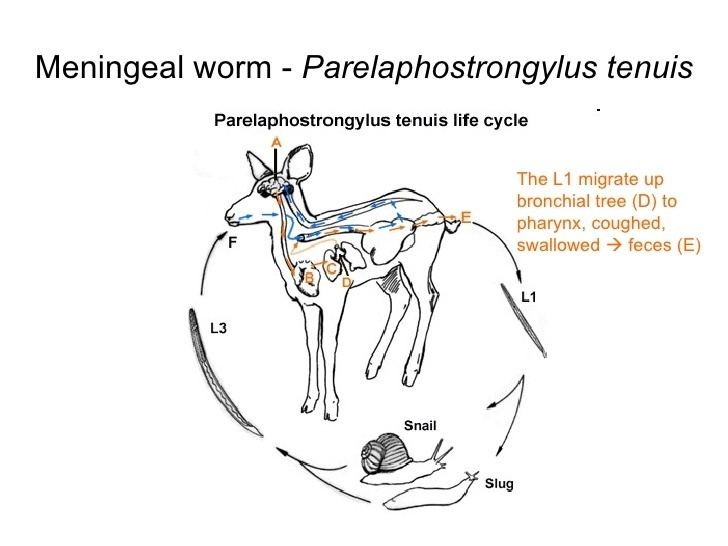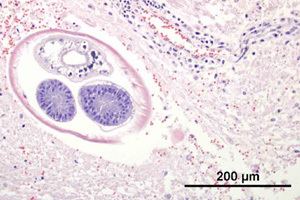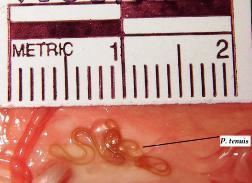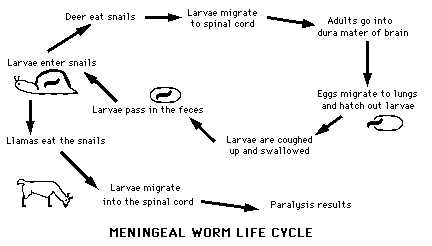Genus Parelaphostrongylus Higher classification Parelaphostrongylus Order Strongylida | Family Protostrongylidae Rank Species | |
 | ||
Scientific name Parelaphostrongylus tenuis Similar Dermacentor albipictus, Odocoileus, Fascioloides magna, Dictyocaulus, Baylisascaris | ||
The lifecycle of parelaphostrongylus tenuis a dramatic interpretation
Parelaphostrongylus tenuis (also known as meningeal worm, brainworm, or Moose illness) is a nematode parasite common to white-tailed deer, Odocoileus virginianus, which causes damage to the central nervous system. Moose (Alces alces), elk (Cervus canadensis), caribou (Rangifer tarandus), and mule deer (Odocoileus hemionus) are also susceptible to the parasite but are aberrant hosts and are infected in neurological instead of meningeal tissue. The frequency of infection in these species increases dramatically when their ranges overlap high densities of white-tailed deer.
Contents
- The lifecycle of parelaphostrongylus tenuis a dramatic interpretation
- Life cycle
- Transmission
- Diagnosis
- Symptomsclinical signs
- History
- Implications
- Other susceptible animals
- Current and past research
- References

The life cycle begins in infected meningeal tissues in the central nervous system where adult worms lay eggs. The eggs are dislodged from the central nervous system and pass into the lungs where they hatch. The larvae are then coughed up, swallowed, and proceed through the gastrointestinal tract. Snails and slugs then serve as intermediate hosts which are later eaten by ungulates allowing the process to continue. Changes in climate and habitat beginning in the early 1900s have expanded range overlap between white-tailed deer and moose, increasing the frequency of infection within the moose population to the concern of wildlife managers.

Life cycle
The life cycle of the parasitic worm P. tenuis is complex and multi-staged.

Adults will lay eggs on the dura mater (the outer layer of the meninges) of the brain or directly into the blood stream of an infected host. The eggs hatch into first stage larvae, which travel in the bloodstream to the lungs where they travel up the respiratory tract, are swallowed, and then pass out of the body in the mucus coating of fecal pellets.

Gastropods such as snails and slugs feed upon the mucus coating of the fecal pellets and ingest the larvae. While in the gastropod, the larvae develop into second and third stage larvae which are capable of infection.

Gastropods carrying second and third stage larvae may be accidentally ingested with plants, which results in the larvae being transmitted to a new host. The larvae then move into the new host's stomach wall and make their way to the central nervous system, as in white-tailed deer, or the brain as in other ungulates. Once in these tissues they will develop into their adult third stage of life and lay eggs to begin the cycle again.
Transmission

Adult P. tenuis can persist for many years in a single host, which allows for many first stage larvae to be shed in feces. It is quite common in many populations of white-tailed deer, which have built up a strong resistance. After gastropod ingestion, moose or other deer may be hosts of the second and third life stage worms. Moose resistance to P. tenuis is much lower than white-tailed deer, which results in a higher mortality rate.
Infected deer density, temperature, climate conditions, and length of transmission periods all affect transmission levels.
Diagnosis
Diagnosis in deer can be conducted by analyzing fecal pellets for larval P. tenuis, or postmortem necropsy to detect presence of adult P. tenuis in the brain cavity or second and third stage worms along the spinal cord. However, brainworm larvae are difficult to distinguish from other parasitic worm species which can also be found in fecal pellets, so detection of adult worms through necropsy is recommended. Diagnosis in moose in conducted with necropsy to detect worms in the brain or spinal cord.
Symptoms/clinical signs
Brainworm affects neurological and behavioral responses. Deer will rarely show any external symptoms of P. tenius infection due to their high acquired resistance. Moose, however, have low resistance, and may show a number of symptoms. Though infrequent, there have been cases of moose recovering from brainworm infection. In both deer and moose, symptom severity does not necessarily vary with severity of infection.
History
In 1912, an unknown neurological disease affecting moose was first reported in Minnesota. Major declines in the moose population were reported, 1925-27 & 1933-34, following the discovery of this unknown disease. It wasn't until 1963 that meningeal worm, Pneumostrongylus tenuis, was determined as the etiological agent causing neurological disease in moose.
It is now known that white-tailed deer populations in the eastern United States are commonly infected with meningeal worm. Infection in the southeastern and western United States is less common. This disease has also been found in the Canadian provinces of Saskatchewan and Manitoba. It appears that the grassland biomes of the United States and Canada act as a barrier to the movement of the disease. Evidence from Canada seems to support this since the western distribution of meningeal worm has changed little since the 1960s.
Implications
The geographic ranges of moose and white-tailed deer were historically separate prior to the twentieth century. Moose are well adapted to winter survival whereas deer are not. They could not withstand the harsh winters in these regions of the northeastern United States and the southeastern provinces of Canada. Deer populations began to move into the southern portions of moose range in the early 1900s following changes in climate, logging, mining, forest fires, and increasing human development. High quality deer habitat associated with these changes has led to dramatic increases in deer abundance in these regions.
White-tailed deer are the normal host of the P. tenuis parasite and are immunologically adapted to its presence. Deer and P. tenuis have coadapted in an evolutionary arms race over time. Deer remain largely unaffected by the presence of P. tenuis because of the immunity they have built as a result of coadaptation. The prevalence and infection rate of P. tenuis in deer is density dependent, meaning that increased rates of infection by the parasite are the result of higher the deer densities.
Moose populations on the southern fringes of their range have recently experienced dramatic declines. As deer encroached upon the southern fringes of moose range, they introduced the parasite to a naïve host, the moose. Upon transmission of the pathogen into moose, the worm causes cerebrospinal nematodiasis, a disease of the nervous system that often results in death. It has been suggested that P. tenuis is one factor that has contributed to moose declines in southern portions of their range. This disruption of host-pathogen dynamics due to habitat alterations has promoted the spread of this parasite to a naïve host and has potentially contributed to declines in moose abundance and productivity in regions with high deer densities. Continued increase in deer abundance and density in the southern fringes of moose range are predicted facilitate sustained transmission of P. tenuis to moose. Continued transmission of deer-related parasites, coupled with low productivity, habitat degradation, and a northward shift in the moose thermonuetral zone, leads to a troubling prognosis for southern moose populations. Murray et al. (2006) predict, if current trends continue, moose populations in these regions will not be viable and population declines will persist.
Other susceptible animals
A variety of ungulates are susceptible to brainworm infection including elk, caribou, mule deer, sheep, goats, and llamas. Severe neurological damage similar to that of infected moose is shown to occur in these species. Similar to the white-tailed deer/moose transmission, snails and slugs that feed on feces are the vectors of the parasite larvae from one host to the next.
Current and past research
The majority of moose brainworm research in North America has been conducted in northern Minnesota, where a historical moose population of 4,000 to 5,000 moose has now declined to an estimated 1,200 individuals. In this region, wildlife managers are challenged to predict and attempt to mitigate moose declines resulting from deer-related pathogens. Because no effective methods to prevent the transmission or infection of brainworm in moose have been found, managers have focused their efforts on decreasing deer densities in these regions. The Minnesota DNR has identified that population densities of >12 deer/square mile result in increased moose mortality as a result of brainworm. Managers in these areas are responsible for evaluating suitable habitat for moose and deer as well as setting management priorities and population goals to decrease the transmission of Parelaphostrongylus tenius in moose.
